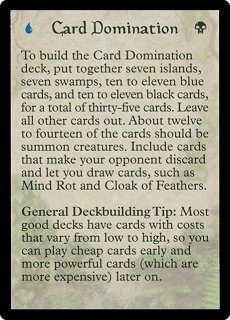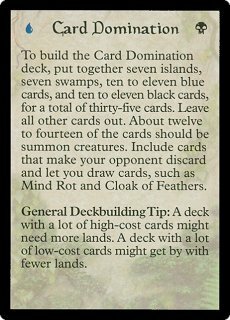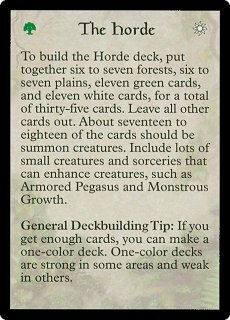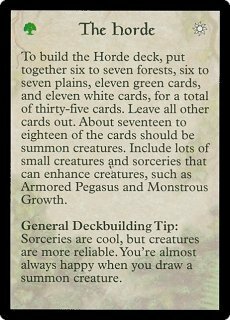 |
| Portal Support Cards |
Index | English Strategy | French Strategy | German Strategy | Spanish Strategy | Japanese Strategy | Traditional Chinese Strategy | English List | French List | German List | Spanish List | Japanese List | Traditional Chinese List | Tip | Rebate
|
001 |
002 |
003 |
||||
|
click card to see backside |
click card to see backside |
click card to see backside |
||||
 |
 |
 |
||||
|
Air Superiority To build the Air Superiority deck, put together seven plains, seven islands, ten to eleven white cards, and ten to eleven blue cards, for a total of thirty-five cards. Leave all other cards out. About fourteen of the cards should be summon creatures. Be sure to include lots of defensive cards and creatures with flying, such as Defiant Stand and Snapping Drake. General Deckbuilding Tip: The more color symbols a card has in its cost, the longer it can take to play it. If you don't get two islands early in the game, you can play a 3U card sooner than you can play a 1UU card. Playing the Air Superiority deck Winning with this deck means playing defense early on and using your large creatures with flying to attack your opponent in the later stages of the game. Since flying creatures are so difficult to intercept, they often make the difference between victory and defeat. Play Tip: Be aggressive with your flying creatures. Don't be afraid to lose them in an attack as long as your opponent has to lose his or hers in order to intercept. |
Air Superiority To build the Air Superiority deck, put together seven plains, seven islands, ten to eleven white cards, and ten to eleven blue cards, for a total of thirty-five cards. Leave all other cards out. About fourteen of the cards should be summon creatures. Be sure to include lots of defensive cards and creatures with flying, such as Defiant Stand and Snapping Drake. General Deckbuilding Tip: Often, when both players have creatures, neither player wants to attack. Most good decks include cards that can let you get through even when your opponent has as many creatures as you do. Playing the Air Superiority deck Winning with this deck means playing defense early on and using your large creatures with flying to attack your opponent in the later stages of the game. Since flying creatures are so difficult to intercept, they often make the difference between victory and defeat. Play Tip: Your creatures with flying are your key to victory. Don't have them intercept and die unless you really need to. |
Card Domination To build the Card Domination deck, put together seven islands, seven swamps, ten to eleven blue cards, and ten to eleven black cards, for a total of thirty-five cards. Leave all other cards out. About twelve to fourteen of the cards should be summon creatures. Include cards that make your opponent discard and let you draw cards, such as Mind Rot and Cloak of Feathers. General Deckbuilding Tip: Most good decks have cards with costs taht vary from low to high, so you can play cheap cards early and more powerful cards (which are more expensive) later on. Playing the Card Domination deck The key to this deck is the "card advantage" it can give you over your opponent. This means that, either by drawing extra cards or making your opponent discard, you have access to more cards than your opponent. Cards represent a player's options throughout a game, so the more cards you have in your hand, the more options you have. Play Tip: The sooner you play cards that let you draw cards, the sooner you can get to the cards you really want. |
|
004 |
005 |
006 |
||||
|
click card to see backside |
click card to see backside |
click card to see backside |
||||
 |
 |
 |
||||
|
Card Domination To build the Card Domination deck, put together seven islands, seven swamps, ten to eleven blue cards, and ten to eleven black cards, for a total of thirty-five cards. Leave all other cards out. About twelve to fourteen of the cards should be summon creatures. Include cards that make your opponent discard and let you draw cards, such as Mind Rot and Cloak of Feathers. General Deckbuilding Tip: A deck with a lot of high-cost cards might need more lands. A deck with a lot of low-cost cards might get by with fewer lands. Playing the Card Domination deck The key to this deck is the "card advantage" it can give you over your opponent. This means that, either by drawing extra cards or making your opponent discard, you have access to more cards than your opponent. Cards represent a player's options throughout a game, so the more cards you have in your hand, the more options you have. Play Tip: When you have sorceries that make your opponent discard, be sure to play them early in the game, while your opponent still has good cards in his or her hand. |
Fiery Doom To build the Fiery Doom deck, put together seven swamps, seven mountains, ten to eleven black cards, and ten to eleven red cards, for a total of thirty-five cards. Leave all other cards out. About eleven to twelve of the cards should be summon creatures. Include cards that deal damage to your opponent's creatires or destroy them outright, such as Volcanic Hammer and Hand of Death. General Deckbuilding Tip: Between games, you can take cards out of your deck and replace them with an equal number of cards of the same color or colors. That way you can learn which cards work best together. Playing the Fiery Doom deck One of red's strengths is dealing damage directly to creatures and opponents, while one of black's strenghths is destroying creatures. These two colors make a potent combination, allowing you to kill off your opponent's creatures while amassing your own army. Soon enough you'll be able to attack with a whole battalion and claim victory. Play Tip: It's better to destroy an enemy creature than to hurt your opponent. The creature can deal you damage or intercept an attacker turn after turn, but the damage you deal your opponent doesn't repeat. |
Fiery Doom To build the Fiery Doom deck, put together seven swamps, seven mountains, ten to eleven black cards, and ten to eleven red cards, for a total of thirty-five cards. Leave all other cards out. About eleven to twelve of the cards should be summon creatures. Include cards that deal damage to your opponent's creatires or destroy them outright, such as Volcanic Hammer and Hand of Death. General Deckbuilding Tip: You generally win by having more creatures in play than your opponent, so include plenty of creatures or plenty of sorceries that destroy your opponent's creatures. Playing the Fiery Doom deck One of red's strengths is dealing damage directly to creatures and opponents, while one of black's strenghths is destroying creatures. These two colors make a potent combination, allowing you to kill off your opponent's creatures while amassing your own army. Soon enough you'll be able to attack with a whole battalion and claim victory. Play Tip: If a sorcery can kill a large creature, don't use it on a small one. Wait until a creature worth destroying comes your way. |
|
007 |
008 |
009 |
||||
|
click card to see backside |
click card to see backside |
click card to see backside |
||||
 |
 |
 |
||||
|
Gargantuans To build the Gargantuans deck, put together seven mountains, seven forests, ten to eleven red cards, and ten to eleven green cards, for a total of thirty-five cards. Leave all other cards out. About thirteen to fourteen of the cards should be summon creatures. Include big creatures, cards that destroy lands, and cards that get you lands, such as Hill Giant and Untamed Wilds. General Deckbuilding Tip: If you want to build a deck with three colors, try five of each land and seven cards of each color. Be sure that none of the cards has more than one color symbol in its cost. Playing the Gargantuans deck Land is perhaps the most valuable resource in Magic™. Without it a player is quickly vanquished. the idea behind this deck is to destroy that resource and then play powerful creatures to deal the death blow. Play Tip: Your big creatures are vulnerable to sorceries that get rid of creatures no matter how big they are. Beware black's Hand of Death and white's Path of Piece. |
Gargantuans To build the Gargantuans deck, put together seven mountains, seven forests, ten to eleven red cards, and ten to eleven green cards, for a total of thirty-five cards. Leave all other cards out. About thirteen to fourteen of the cards should be summon creatures. Include big creatures, cards that destroy lands, and cards that get you lands, such as Hill Giant and Untamed Wilds. General Deckbuilding Tip: On average in a thirty-five-card deck with fourteen lands, you'll be able to play five lands by turn five or six, six lands by turn eight, and seven lands by turn ten or eleven. Playing the Gargantuans deck Land is perhaps the most valuable resource in Magic™. Without it a player is quickly vanquished. the idea behind this deck is to destroy that resource and then play powerful creatures to deal the death blow. Play Tip: When you have sorceries that destroy lands, play them as soon as possible in the game, before your opponent can play big creatures. |
The Horde To build the Horde deck, put together seven forests, six to seven plains, eleven green cards, and eleven white cards, for a total of thirty-five cards. Leave all other cards out. About seventeen to eighteen of the cards should be summon creatures. Include lots of small creatures and sorceries that can enhance creatures, such as Armored Pegasus and Monstrous Growth. General Deckbuilding Tip: If you get enough cards, you can make a one-color deck. One-color decks are strong in some areas and weak in others. Playing the Horde deck By producing a constant supply of small creatures, you can quickly overwhelm your opponent, first by striking before he or she has any creatures to intercept the attackers, and later by attacking with so many creatures that he or she can't intercept them all. Combined with cards that enhance your creatures, this strategy can end the game rapidly. Play Tip: Save sorceries that enhance all your creatures until you have a bunch of creatures to use them on. |
|
010 |
||||||
|
click card to see backside |
||||||
 |
||||||
|
The Horde To build the Horde deck, put together seven forests, six to seven plains, eleven green cards, and eleven white cards, for a total of thirty-five cards. Leave all other cards out. About seventeen to eighteen of the cards should be summon creatures. Include lots of small creatures and sorceries that can enhance creatures, such as Armored Pegasus and Monstrous Growth. General Deckbuilding Tip: Sorceries are cool, but creatures are more reliable. You're almost always happy when you draw a summon creature. Playing the Horde deck By producing a constant supply of small creatures, you can quickly overwhelm your opponent, first by striking before he or she has any creatures to intercept the attackers, and later by attacking with so many creatures that he or she can't intercept them all. Combined with cards that enhance your creatures, this strategy can end the game rapidly. Play Tip: Play summon creatures as soon as you can, and attack as often as possible. Don't be afraid to attack and lose a creature if you can deal damage to your opponent. |